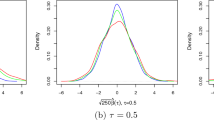Abstract
A new odd log-logistic unit omega distribution is defined and studied, and some of its structural properties are obtained. A quantile regression model based on the new re-parameterized distribution is constructed, and the estimation is conducted by the maximum likelihood method. Monte Carlo simulations are used to assess the accuracy of the estimators. The flexibility, practical relevance and applicability of the proposed regression are proved by means of Human Development Index data from the cities of the state of São Paulo (Brazil).










Similar content being viewed by others
References
Bakouch HS, Nik AS, Asgharzadeh A, Salinas HS (2021) A flexible probability model for proportion data: unit-half-normal distribution. Commun Stat: Case Stud, Data Anal and Appl 7(2):271–288
Bayes CL, Bazán JL, De Castro M (2017) A quantile parametric mixed regression model for bounded response variables. Stat and its Interf 10(3):483–493
Cancho VG, Bazán JL, Dey DK (2020) A new class of regression model for a bounded response with application in the study of the incidence rate of colorectal cancer. Stat Methods Med Res 29(7):2015–2033
Cole TJ, Green PJ (1992) Smoothing reference centile curves: the LMS method and penalized likelihood. Stat Med 11(10):1305–1319
Ferrari S, Cribari-Neto F (2004) Beta regression for modelling rates and proportions. J Appl Stat 31(7):799–815
Ghitany ME, Mazucheli J, Menezes AFB, Alqallaf F (2019) The unit-inverse Gaussian distribution: a new alternative to two-parameter distributions on the unit interval. Commun in Stat -Theory and Methods 48(14):3423–3438
Gijbels I, Karim R, Verhasselt A (2021) Semiparametric quantile regression using family of quantile-based asymmetric densities. Comput Stat & Data Anal 157:107–129
Gleaton JU, Lynch JD (2006) Properties of generalized log-logistic families of lifetime distributions. J Probability and Stat Sci 4(1):51–64
Gómez-Déniz E, Sordo MA, Calderín-Ojeda E (2014) The Log-Lindley distribution as an alternative to the beta regression model with applications in insurance. Insurance Math Econ 54:49–57
Gradshteyn IS, Ryzhik IM (2000) Table of Integrals, Series, and Products. Academic Press, New York
Hairer E (1993) Backward analysis of numerical integrators and symplectic methods
Jodra P, Jimenez-Gamero MD (2020) A quantile regression model for bounded responses based on the exponential-geometric distribution. REVSTAT-Statistical J 18(4):415–436
Kenney JF, Keeping ES (1962) Kurtosis. MathStat 3:102–103
Kieschnick R, McCullough BD (2003) Regression analysis of variates observed on (0, 1): percentages, proportions and fractions. Stat Model 3(3):193–213
Koenker R, Bassett Jr G (1978) Regression quantiles. Econometrica: J Econ Soc 33-50
Koenker R, Machado JA (1999) Goodness of fit and related inference processes for quantile regression. J Am Stat Assoc 94(448):1296–1310
Kolman B, Beck RE (1995) Elementary linear programming with applications. Gulf Professional Publishing
Korkmaz MÇ, Chesneau C, Korkmaz ZS (2021) Transmuted unit Rayleigh quantile regression model: alternative to beta and Kumaraswamy quantile regression models. Univ Politeh Buchar Sci Bull Ser Appl Math and Phys 83(3):149–158
Korkmaz MÇ, Chesneau C (2021) On the unit Burr-XII distribution with the quantile regression modeling and applications. Comput Appl Math 40(1):1–26
Korkmaz MÇ, Altun E, Chesneau C, Yousof HM (2022) On the unit-Chen distribution with associated quantile regression and applications. Math Slovaca 72(3):765–786
Kumaraswamy P (1980) A generalized probability density function for double-bounded random processes. J Hydrol 46(1–2):79–88
Leiva V, Mazucheli J, Alves B (2023) A novel regression model for fractiles: formulation, computational aspects, and applications to medical data. Fractal and Fract 7(2):169
Liu Y, Wu Y (2011) Simultaneous multiple non-crossing quantile regression estimation using kernel constraints. J Nonparametric Stat 23(2):415–437
Mazucheli J, Menezes AFB, Dey S (2018) The unit-Birnbaum-Saunders distribution with applications. Chilean J Stat 9(1):47–57
Mazucheli J, Menezes AFB, Chakraborty S (2019) On the one parameter unit-Lindley distribution and its associated regression model for proportion data. J Appl Stat 46(4):700–714
Mazucheli J, Menezes AFB, Fernandes LB, De Oliveira RP, Ghitany ME (2020) The unit-Weibull distribution as an alternative to the Kumaraswamy distribution for the modeling of quantiles conditional on covariates. J Appl Stat 47(6):954–974
Mazucheli J, Alves B, Menezes AFB, Leiva V (2022) An overview on parametric quantile regression models and their computational implementation with applications to biomedical problems including COVID-19 data. Comput Methods Programs Biomed 221:1–42
Moors J (1988) A quantile alternative for kurtosis. The Statistician 37(1):25–32
Okorie IE, Nadarajah S (2019) On the omega probability distribution. Qual Reliab Eng Int 35(6):2045–2050
Rigby RA, Stasinopoulos DM (2005) Generalized additive models for location, scale and shape. J Roy Stat Soc: Ser C (Appl Stat) 54(3):507–554
Roser Max (2014) Human development index (HDI). Our World in Data
Tahir MH, Nadarajah S (2015) Parameter induction in continuous univariate distributions: well-established G families. An Acad Bras Ciênc 87(2):539–568
Vasconcelos JCS, Prataviera F, Ortega EMM, Cordeiro GM (2022) An extended logit-normal regression with application to human development index data. Commun Statistics-Simul Comput. https://doi.org/10.1080/03610918.2022.2045497
Author information
Authors and Affiliations
Corresponding author
Additional information
Publisher's Note
Springer Nature remains neutral with regard to jurisdictional claims in published maps and institutional affiliations.
Appendices
Appendix: Simulation plots
Appendix: Score equations
Rights and permissions
About this article
Cite this article
Cordeiro, G.M., Rodrigues, G.M., Prataviera, F. et al. A new quantile regression model with application to human development index. Comput Stat 39, 2925–2948 (2024). https://doi.org/10.1007/s00180-023-01413-w
Received:
Accepted:
Published:
Issue Date:
DOI: https://doi.org/10.1007/s00180-023-01413-w






